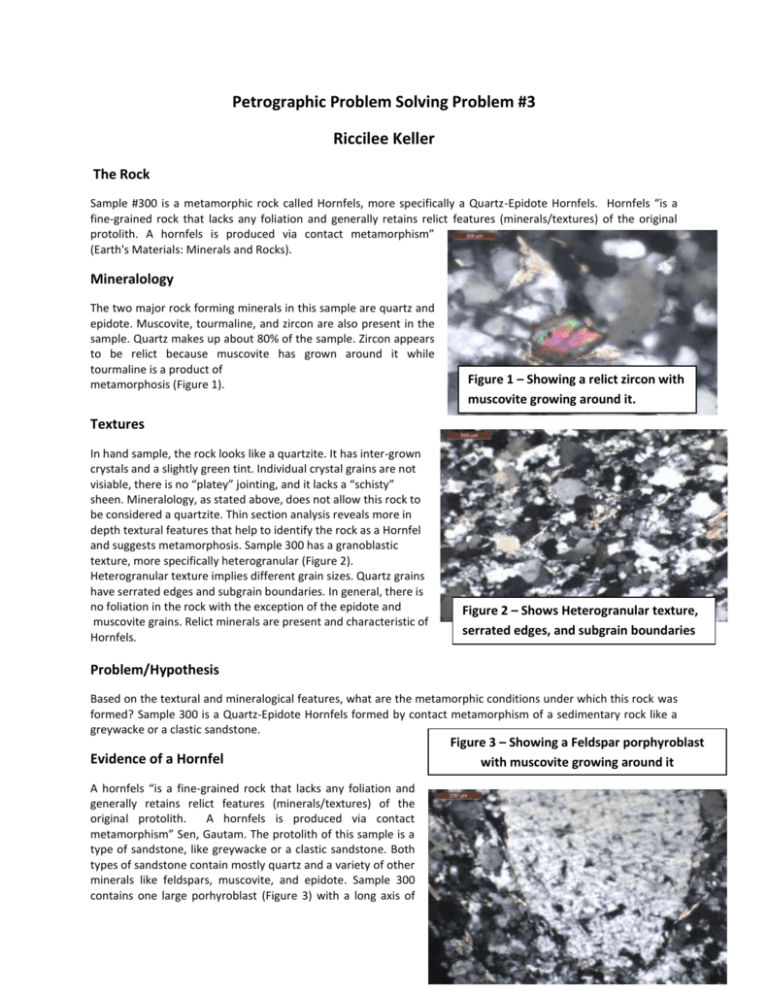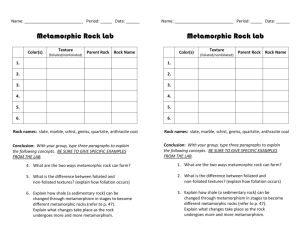300
advertisement

Petrographic Problem Solving Problem #3 Riccilee Keller The Rock Sample #300 is a metamorphic rock called Hornfels, more specifically a Quartz-Epidote Hornfels. Hornfels “is a fine-grained rock that lacks any foliation and generally retains relict features (minerals/textures) of the original protolith. A hornfels is produced via contact metamorphism” (Earth's Materials: Minerals and Rocks). Mineralology The two major rock forming minerals in this sample are quartz and epidote. Muscovite, tourmaline, and zircon are also present in the sample. Quartz makes up about 80% of the sample. Zircon appears to be relict because muscovite has grown around it while tourmaline is a product of metamorphosis (Figure 1). Figure 1 – Showing a relict zircon with muscovite growing around it. Textures In hand sample, the rock looks like a quartzite. It has inter-grown crystals and a slightly green tint. Individual crystal grains are not visiable, there is no “platey” jointing, and it lacks a “schisty” sheen. Mineralology, as stated above, does not allow this rock to be considered a quartzite. Thin section analysis reveals more in depth textural features that help to identify the rock as a Hornfel and suggests metamorphosis. Sample 300 has a granoblastic texture, more specifically heterogranular (Figure 2). Heterogranular texture implies different grain sizes. Quartz grains have serrated edges and subgrain boundaries. In general, there is no foliation in the rock with the exception of the epidote and muscovite grains. Relict minerals are present and characteristic of Hornfels. Figure 2 – Shows Heterogranular texture, serrated edges, and subgrain boundaries Problem/Hypothesis Based on the textural and mineralogical features, what are the metamorphic conditions under which this rock was formed? Sample 300 is a Quartz-Epidote Hornfels formed by contact metamorphism of a sedimentary rock like a greywacke or a clastic sandstone. Evidence of a Hornfel A hornfels “is a fine-grained rock that lacks any foliation and generally retains relict features (minerals/textures) of the original protolith. A hornfels is produced via contact metamorphism” Sen, Gautam. The protolith of this sample is a type of sandstone, like greywacke or a clastic sandstone. Both types of sandstone contain mostly quartz and a variety of other minerals like feldspars, muscovite, and epidote. Sample 300 contains one large porhyroblast (Figure 3) with a long axis of Figure 3 – Showing a Feldspar porphyroblast with muscovite growing around it approximately 1300 microns. The porhyroblast is considered idio-subidioblastic, meaning well-moderately formed, synonymous with euhedral-subhedral. The porhyroblast is not in equilibrium; it shows undutlatory extinction. The extinction of the crystal is suggestive of a quartz, however it appears to have cleavage and the interference figure looks biaxial. Based on these observations, the porphyroblast is a feldspar that originates from the protolith. Tourmaline and zircon also appear to be relict minerals of the protolith; both have minor amounts of muscovite growing around them. Evidence of Contact Metamorphosis Figure 4 – Showing preferred orientation to muscovite grains Contact metamorphism occurs when a magma body comes into contact with pre-existing rocks. Contact metamorphism produces non-foliated rocks such as marble, quartzite, and hornfels (http://volcano.oregonstate.edu). When a magma body intrudes a solid rock complex, it causes deformation and metamorphism to occur. As heat moves out from a magma body, it causes the protolith to recrystallize and deform. Dynamic recrystallization supports many of the textural features found in the rock. Serrated grain boundaries are evidence of disequilibrium between crystal grains. “Grain sizes decrease, with increased differential stress, in an attempt to reduce strain energy during deformation” (1). Grain sizes in the sample appear to be trending toward isogrannular as opposed to heterogrannular; this supports the idea that as the magma body intrudes the protolith, strain and stress occur and continue as intrusion continues. Preferred orientations of muscovite (Figure 4) grains are also suggestive of contact metamorphism. Pressure during regional metamorphism increases with temperature and would cause the rock to show more foliation. Intrusion of a magma body will cause slight pressure on the rock as it intrudes; this is the cause of the preferred orientation observed with the muscovite. Conclusion Sample 300 is a Quartz-Epidote Hornfel. Supporting evidence includes the presence of a porphyroblast, lack of foliation, and mineralology. Because there is less than 90% quartz, the idea that this sample is a quartzite has been refuted. Contact metamorphism is supported by the idea of dynamic recrystallization causing serrated edges and changes in subgrain boundaries. By using the metamorphic facies diagram as a general template for the rock type, it can be generalized that this rock, during contact metamorphism, formed at moderate to high temperatures under low pressure. References 1. Shelley, David. Igneous and Metamorphic Rocks under the Microscope: Classification, Textures, Microstructures, and Mineral Preferred-orientations. London: Chapman & Hall, 1983. Print. 2. http://web.arc.losrios.edu/~borougt/TempPressureEnv.jpg







